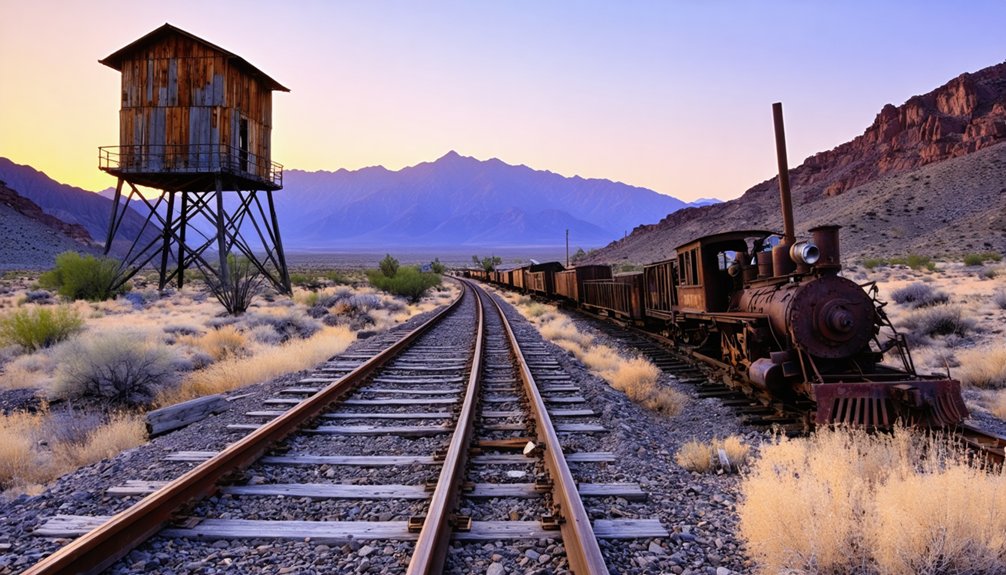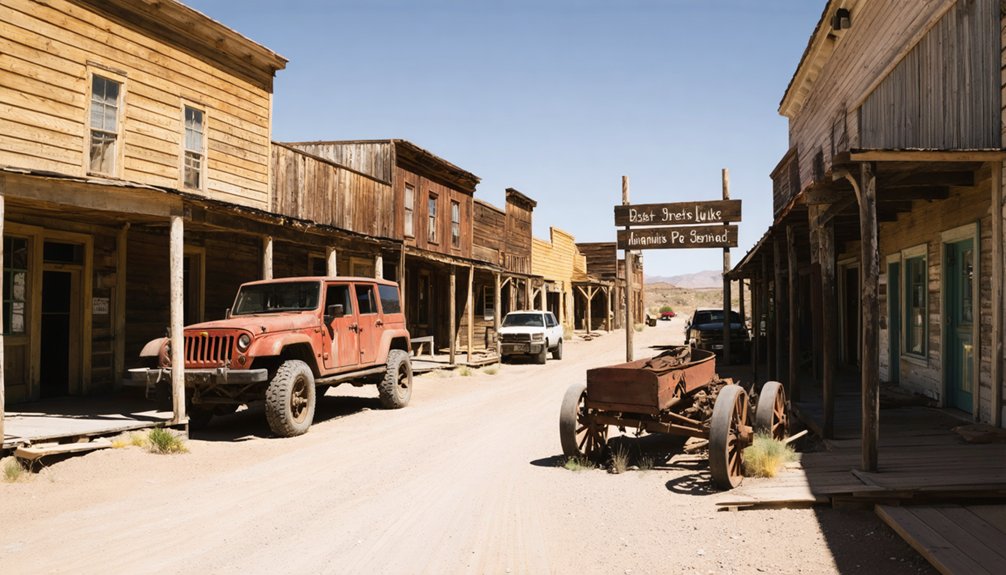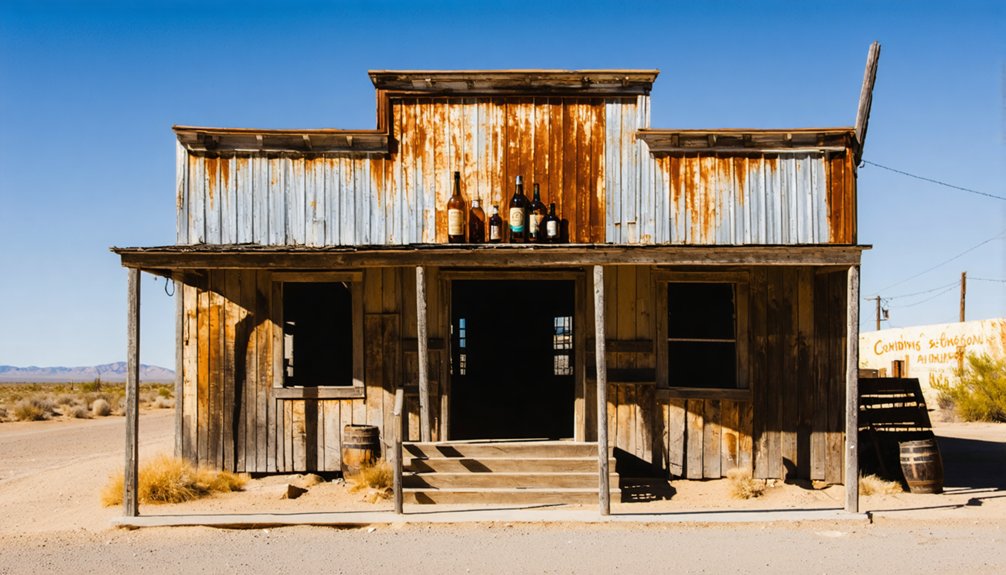You’ll discover Crown King nestled at 5,771 feet in Arizona’s Bradshaw Mountains, where gold discoveries in the 1870s transformed a mining camp into a bustling frontier town. Though mining operations declined after 1910, this resilient community avoided becoming a true ghost town. Today, 100-150 year-round residents preserve historic treasures like the 1906 Crown King Saloon while welcoming visitors. The winding mountain road leads to more than just scenic pine forests.
Key Takeaways
- Crown King emerged in 1888 after N.C. Sheckels staked his claim, becoming a thriving frontier mining town with 1,000 residents by 1871.
- Despite being labeled a “ghost town,” Crown King maintains 100-150 year-round residents and active tourism centered around its historical mining heritage.
- The Crown King Saloon, built in the 1880s and relocated in 1906, remains the social center of the community.
- Mining operations flourished from 1888-1908 but declined by 1920 due to diminishing ore quality, high costs, and water shortages.
- Visitors can explore remaining historical structures and learn about the area’s gold rush history that began in the 1870s.
The Rise of a Mountain Mining Camp
Whispers of gold echoed through the southern Bradshaw Mountains in the 1870s, forever changing the rugged Arizona landscape as prospectors discovered rich gold-bearing ore.
The allure of precious metal transformed Arizona’s wild country into a beacon for fortune-seekers and dreamers alike.
You’d have found N.C. Sheckels staking his claim in 1888, renaming it the Crowned King before partnering with Place and Harrington to form a proper mining company by 1890.
The community dynamics quickly evolved from a simple collection of boardinghouses and an assay office into a thriving frontier town.
As mining techniques advanced, electricity powered the operations by 1896—a luxury few remote camps enjoyed.
Despite the challenging terrain, Crown King attracted not just miners but entrepreneurs establishing saloons, restaurants, and services along the stage road connecting the mine to the mill. The first business venture in town was actually a saloon operated by Ike Patrick, which faced opposition from Place who worried about its influence on miners.
The Crown King Mine stood as the largest mine in the Bradshaw range, with a nearby mill processing the valuable ore.
Gold Rush in the Bradshaw Mountains
When you explore the rugged slopes of the Bradshaw Mountains, you’re walking the same gold-rich terrain that William and Isaac Bradshaw discovered in 1863, where they reportedly collected up to an ounce of gold daily along the Hassayampa River.
The news of their success triggered Arizona’s first major gold rush, quickly transforming these remote mountains into a bustling frontier of placer claims and makeshift mining camps.
As surface deposits yielded their treasures, miners shifted from simple panning to more complex lode mining operations, establishing over 40 settlements throughout the range before the boom eventually faded in the early 1900s. The region is noted for having some of the best producing placer claims in all of Arizona. Mining activities in this area were frequently disrupted by Apache conflicts, which limited development until the establishment of Indian reservations in 1872.
Striking Gold
As gold fever swept across the American West in the mid-19th century, the rugged Bradshaw Mountains revealed their gleaming secrets to a wave of determined prospectors.
The story began in 1863 when Captain Joe Walker’s party discovered rich deposits at Lynx Creek, where miners recovered an ounce or more daily through placer mining.
Named after William and Isaac Bradshaw, who found precious metals that same year, the range quickly gained historical significance following the Bradshaw Indian War of 1873.
Hundreds flocked to work the productive fields at Big Bug Creek, Groom Creek, and the upper Hassayampa River. The peak of this mining activity occurred during the 1870s and 1880s when various gold districts throughout the mountains were extensively worked.
You’ll find the region’s Precambrian schist and granite intrusions created ideal conditions for both placer and lode gold deposits, fueling a rush that established dozens of mining camps across this mineral-rich wilderness. These operations employed various extraction methods including hard rock mining to access deeper mineral veins beneath the surface.
Mining Boom Era
The gold-laden earth of the Bradshaw Mountains yielded its first major treasure on July 4, 1870, when prospector Jackson McCracken and his partners struck pay dirt at the Del Pasco Mine near Towers Mountain.
That initial strike produced 112 ounces of gold worth $1,904, igniting a fevered rush that transformed the rugged landscape.
You’d have witnessed remarkable economic expansion following the Bradshaw Indian War’s end in 1873, as miners flooded into camps like Crown King.
Gold mining operations evolved rapidly from primitive methods to organized industry, with these key developments:
- Arrastras crushing ore by August 1870
- Nearly 1,000 residents populating Bradshaw City by 1871
- Over 40 mining camps established throughout the mountains
- Bradshaw Mountain Railroad incorporated in 1901
The Miner newspaper in Prescott boldly declared Del Pasco as the richest gold mine in the world, further fueling the area’s reputation.
Despite the silver market’s collapse during the 1873 Panic, gold mining persisted until 1930.
The Tiger mine was particularly noteworthy, situated at 6,359 feet elevation and producing approximately $2,500,000 in silver before the area’s decline.
Traveling the Treacherous Crown King Road
Winding through Arizona’s rugged terrain, the infamous Crown King Road challenges even the most seasoned off-road enthusiasts with its 26.1 miles of washboarded gravel, sharp switchbacks, and narrow passages.
You’ll need a high-clearance 4×4 with at least 8 inches of ground clearance to tackle this unmaintained route safely. Recent drivers report severe washboarding making the journey particularly uncomfortable without aired down tires.
Road safety demands vigilance for softball-sized rocks, blind corners, and sections barely wide enough for one vehicle. Vehicle preparation is critical—carry recovery gear and spare tires, as you’ll find no services along the way.
While 4WD isn’t always necessary in dry conditions, monsoon season transforms this moderate trail into a treacherous muddy challenge. The journey’s difficulty increases significantly beyond Crown King with many washouts and loose rocks creating hazardous conditions.
For the freedom-seeker, spring and fall offer the most forgiving conditions. Always check current closures—wildfires frequently restrict access to this backcountry adventure.
Life and Death in a Mining Boomtown
As you wander Crown King’s weathered streets today, it’s easy to forget the stark contrast between the gilded dreams of $180,000-per-ton ore strikes and the harsh realities of life where men drowned transporting bullion and miners risked their lives daily.
You’ll notice the town cemetery telling silent tales of those who succumbed to accidents, disease, and the unforgiving mountain environment that claimed many during the boom years.
The dangerous allure of mining wealth once drew a thousand souls to build 800 structures in this remote mountain outpost, where electric lights blazed through the night and fortunes were made and lost as quickly as the stamp mills could crush ore.
Gilded Dreams, Harsh Realities
Behind every gold nugget plucked from Crown King’s mountains lay stories of triumph and tragedy that defined life in this rugged mining boomtown.
You’d find gilded illusions of instant wealth alongside harsh truths of nature’s wrath and human conflict.
While rich ore strikes promised fortunes worth $180,000 per ton, the reality included:
- Treacherous mountain roads that challenged equipment transport
- Devastating storms that washed away infrastructure and lives
- Water shortages that crippled mill operations
- Bitter legal battles that eventually shut down operations
You might’ve witnessed George Harrington’s miraculous escape from a flooded creek in 1897, while freighter J.P. Bruce perished alongside $5,000 in gold bullion—treasure never recovered.
Despite extracting $2 million in gold, no lasting fortunes emerged from Crown King’s boom, only stories of what might’ve been.
Cemetery Tells Tales
Three weathered tombstones in Crown King’s hillside cemetery tell more about life in this mining boomtown than any history book ever could.
You’ll find grave markers ranging from simple wooden crosses to elaborate monuments, each revealing the stark social divides of the era.
The cemetery’s historical significance lies in its demographic insights—where Chinese laborers’ distinctive burial practices neighbor the resting places of wealthy mine owners.
Trace your fingers across tombstone symbols depicting mining tools that honor victims of cave-ins and explosions.
J.P. Bruce’s memorial—the freighter who drowned with $5,000 in bullion—stands among countless others who shaped this community.
These stones aren’t just cultural heritage; they’re unfiltered narratives of labor contributions, family struggles, and the true cost of Crown King’s fleeting prosperity.
Mining’s Dangerous Allure
Beyond the weathered tombstones lie the even more harrowing stories of Crown King’s rise and fall.
You’d have risked your life daily descending shafts reaching 650 feet deep, extracting gold-laden ore in darkness for meager wages. The town’s very existence hinged on these dangerous labors, creating a volatile community where fortunes changed with each new vein discovered.
Environmental impact and labor struggles shaped Crown King’s destiny through:
- Devastating floods that washed away fortunes worth $30,000 overnight
- Chronic water shortages that repeatedly halted mill operations
- Declining ore quality that turned dreams to dust as mines deepened
- Hazardous working conditions that claimed unknown numbers of miners
When the gold vanished, so did prosperity, leaving behind an “active ghost town” testifying to mining’s dangerous allure.
The Crown King Saloon: Heart of the Community
The weathered Crown King Saloon stands as the beating heart of this historic mining town, its timeworn wooden floors and slowly rotating ceiling fans telling stories from a bygone era.
Originally built in the 1880s in Oro Belle, Tom Anderson relocated the structure piece by piece to Crown King around 1906, establishing what would become the town’s social nucleus.
You’ll find the walls adorned with historic photographs chronicling Crown King’s mining heritage, while the distinctive white-pillared upper patio evokes an old paddleboat aesthetic.
For over a century, this saloon has hosted miners, gamblers, and travelers seeking camaraderie and cold drinks.
Today, it continues its tradition as a community gathering spot, hosting events like the Annual Chili Cook-Off, while MJ’s Cafe serves hungry visitors in back.
Railroad Tales: Connecting the Wilderness

When Frank M. Murphy incorporated the Bradshaw Mountain Railroad in 1901, he released one of the West’s most remarkable railroad engineering feats.
You can still trace the path where trains once conquered the impossible—climbing steep mountain grades through ten switchbacks in just seven miles of rugged terrain.
The railroad transformed mining logistics and Crown King itself, which relocated to accommodate the bustling activity.
While traveling the old railroad grade (now a rugged road), imagine:
- Irish tracklayers battling rattlesnakes and blizzards during construction
- Ore-laden trains maneuvering treacherous switchbacks
- A five-hour journey connecting remote miners to civilization
- The economic boom that followed, with gold production exceeding $1 million annually by 1907
Tales From the Crown King Cemetery
Nestled among fragrant ponderosa pines just a quarter-mile from Crown King’s town center, the Main Cemetery tells silent stories of frontier hardship and human perseverance.
You’ll find weathered wooden markers and stone monuments dating back to the 1880s, each revealing the stark reality of mining life.
The grave stories are haunting yet compelling—epitaphs describe men “lost in mine collapse” or “killed by blasting accident.”
Weathered stones whisper brutal mining tragedies—men crushed by earth or torn apart by dynamite’s unforgiving force.
Others succumbed to influenza, tuberculosis, or the seventeen violent deaths recorded in the 1890s. The Bishop family markers stand alongside poignant tales of reinterments.
Unlike many ghost town cemeteries, Crown King’s burial ground remains well-preserved thanks to the town’s continued habitation, offering profound historical significance as a living document of Arizona’s mining heritage.
From Mining Mecca to Tourist Destination

While final resting places tell tales of Crown King’s hardships, the town’s economic heartbeat reveals an equally compelling story of boom and bust.
You’re witnessing a remarkable economic shift as you explore this former mining mecca—where the Crown King Mining Company once produced high-grade ore and employed hundreds.
The cultural heritage evolved through distinct phases:
- 1888-1908: Peak mining years with daily production of valuable gold and silver concentrates
- 1910-1920: Steady decline as ore quality diminished and transportation costs soared
- 1920-1970: Sporadic mining attempts amid growing abandonment
- 1970-Present: Rebirth as a tourist destination with about 100 permanent residents
When you visit today, you’re not just seeing a ghost town—you’re experiencing freedom from the industrial past while honoring its legacy.
Exploring Crown King Today: A Living Ghost Town
Unlike most American ghost towns that stand completely abandoned, Crown King thrives as a living relic of the past. With 100-150 year-round residents, this mountain hideaway balances historic preservation with everyday life.
You’ll navigate rugged, unpaved roads requiring 4WD vehicles to reach this secluded community, making the journey part of the adventure.
Once there, park near the town center and explore original 19th-century structures that house modern businesses. The Crown King Saloon offers local cuisine in a setting virtually unchanged since mining days.
Weekends bring live western music and community gatherings, while nearby trails invite hiking and off-roading.
This isn’t a museum—it’s a functioning community where history breathes alongside residents who’ve chosen a slower pace of life far from urban constraints.
Frequently Asked Questions
Is There Cell Phone Service or Internet in Crown King?
Yes, you’ll find limited cell coverage and internet availability. AT&T offers the strongest signal at 85-100% coverage, while Verizon covers 76-90%. T-Mobile’s weaker service reaches only 40% of the area.
What Emergency Services Are Available in This Remote Location?
Like a sentinel in the wilderness, Crown King offers emergency services through their volunteer fire department. You’ll find first aid, fire suppression, and basic EMS. Keep emergency contacts handy—dial 911 or 928-632-7163 when needed.
How Severe Are Winter Conditions and Road Access?
Winter conditions can be treacherous with significant snowfall making roads impassable. You’ll face minimal road maintenance on single-width paths with steep switchbacks. Your winter preparedness must include high-clearance 4×4 vehicles for freedom in this wilderness.
Are There Any Paranormal or Ghost Stories About Crown King?
You’ll encounter rich haunted tales throughout Crown King, from ghostly miners in abandoned shafts to unexplained voices at the historic saloon. Ghost sightings frequently occur near the cemetery and old mining sites.
What Wildlife Might Visitors Encounter in the Surrounding Forest?
From bears to birds, your wildlife encounters in Crown King’s forests won’t disappoint! You’ll likely spot mule deer, coyotes, bobcats, javelinas, and Abert’s squirrels among the ponderosa pines and oak-dotted landscape.
References
- https://www.arizonan.com/ghost-towns/crown-king/
- https://www.desertusa.com/desert-arizona/crown-king-mine.html
- https://www.apcrp.org/Crown King/Crown_King_071607.htm
- https://azoffroad.net/crown-king
- http://www.visitcrownking.com/about-crownking/
- https://www.azcentral.com/story/travel/arizona/2025/03/21/unique-day-trips-from-phoenix-crown-king-az/82418338007/
- https://www.mininghistoryassociation.org/CrownKing.htm
- https://www.bumblebeeranch.com/history-of-bumble-bee
- https://www.youtube.com/watch?v=pSvPmCT4e3o
- https://crownking.com/history/



